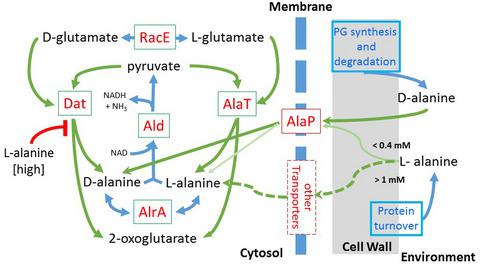当前位置:
X-MOL 学术
›
Mol. Microbiol.
›
论文详情
Our official English website, www.x-mol.net, welcomes your
feedback! (Note: you will need to create a separate account there.)
Alanine metabolism in Bacillus subtilis
Molecular Microbiology ( IF 2.6 ) Pub Date : 2020-11-06 , DOI: 10.1111/mmi.14640 Karzan R Sidiq 1 , Man W Chow 1 , Zhao Zhao 1 , Richard A Daniel 1
Molecular Microbiology ( IF 2.6 ) Pub Date : 2020-11-06 , DOI: 10.1111/mmi.14640 Karzan R Sidiq 1 , Man W Chow 1 , Zhao Zhao 1 , Richard A Daniel 1
Affiliation

|
Both isomeric forms of alanine play a crucial role in bacterial growth and viability; the L‐isomer of this amino acid is one of the building blocks for protein synthesis, and the D‐isomer is incorporated into the bacterial cell wall. Despite a long history of genetic manipulation of Bacillus subtilis using auxotrophic markers, the genes involved in alanine metabolism have not been characterized fully. In this work, we genetically characterized the major enzymes involved in B. subtilis alanine biosynthesis and identified an alanine permease, AlaP (YtnA), which we show has a major role in the assimilation of D‐alanine from the environment. Our results provide explanations for the puzzling fact that growth of B. subtilis does not result in the significant accumulation of extracellular D‐alanine. Interestingly, we find that in B. subtilis, unlike E. coli where multiple enzymes have a biochemical activity that can generate alanine, the primary synthetic enzyme for alanine is encoded by alaT, although a second gene, dat, can support slow growth of an L‐alanine auxotroph. However, our results also show that Dat mediates the synthesis of D‐alanine and its activity is influenced by the abundance of L‐alanine. This work provides valuable insights into alanine metabolism that suggests that the relative abundance of D‐ and L‐alanine might be linked with cytosolic pool of D and L‐glutamate, thereby coupling protein and cell envelope synthesis with the metabolic status of the cell. The results also suggest that, although some of the purified enzymes involved in alanine biosynthesis have been shown to catalyze reversible reactions in vitro, most of them function unidirectionally in vivo.
中文翻译:

枯草芽孢杆菌中的丙氨酸代谢
丙氨酸的两种异构形式在细菌生长和活力中都起着至关重要的作用。该氨基酸的 L 异构体是蛋白质合成的基石之一,而 D 异构体则结合到细菌细胞壁中。尽管使用营养缺陷标记对枯草芽孢 杆菌进行基因操作已有很长的历史,但尚未完全表征参与丙氨酸代谢的基因。在这项工作中,我们对B 中涉及的主要酶进行了遗传表征。枯草芽孢杆菌丙氨酸生物合成并鉴定了一种丙氨酸渗透酶 AlaP (YtnA),我们表明它在从环境中吸收 D-丙氨酸中起主要作用。我们的结果为B 的增长这一令人费解的事实提供了解释。枯草芽孢杆菌不会导致细胞外 D-丙氨酸的显着积累。有趣的是,我们发现在B 中。枯草芽孢杆菌,与E不同。在大肠杆菌中,多种酶具有可以产生丙氨酸的生化活性,丙氨酸的主要合成酶由alaT编码,尽管第二个基因dat, 可以支持 L-丙氨酸营养缺陷型的缓慢生长。然而,我们的结果还表明,Dat 介导 D-丙氨酸的合成,其活性受 L-丙氨酸丰度的影响。这项工作为丙氨酸代谢提供了有价值的见解,表明 D- 和 L-丙氨酸的相对丰度可能与 D 和 L-谷氨酸的胞质池有关,从而将蛋白质和细胞包膜合成与细胞的代谢状态相结合。结果还表明,虽然一些参与丙氨酸生物合成的纯化酶已被证明在体外催化可逆反应,但其中大多数在体内发挥单向作用。
更新日期:2020-11-06
中文翻译:

枯草芽孢杆菌中的丙氨酸代谢
丙氨酸的两种异构形式在细菌生长和活力中都起着至关重要的作用。该氨基酸的 L 异构体是蛋白质合成的基石之一,而 D 异构体则结合到细菌细胞壁中。尽管使用营养缺陷标记对枯草芽孢 杆菌进行基因操作已有很长的历史,但尚未完全表征参与丙氨酸代谢的基因。在这项工作中,我们对B 中涉及的主要酶进行了遗传表征。枯草芽孢杆菌丙氨酸生物合成并鉴定了一种丙氨酸渗透酶 AlaP (YtnA),我们表明它在从环境中吸收 D-丙氨酸中起主要作用。我们的结果为B 的增长这一令人费解的事实提供了解释。枯草芽孢杆菌不会导致细胞外 D-丙氨酸的显着积累。有趣的是,我们发现在B 中。枯草芽孢杆菌,与E不同。在大肠杆菌中,多种酶具有可以产生丙氨酸的生化活性,丙氨酸的主要合成酶由alaT编码,尽管第二个基因dat, 可以支持 L-丙氨酸营养缺陷型的缓慢生长。然而,我们的结果还表明,Dat 介导 D-丙氨酸的合成,其活性受 L-丙氨酸丰度的影响。这项工作为丙氨酸代谢提供了有价值的见解,表明 D- 和 L-丙氨酸的相对丰度可能与 D 和 L-谷氨酸的胞质池有关,从而将蛋白质和细胞包膜合成与细胞的代谢状态相结合。结果还表明,虽然一些参与丙氨酸生物合成的纯化酶已被证明在体外催化可逆反应,但其中大多数在体内发挥单向作用。





















































 京公网安备 11010802027423号
京公网安备 11010802027423号